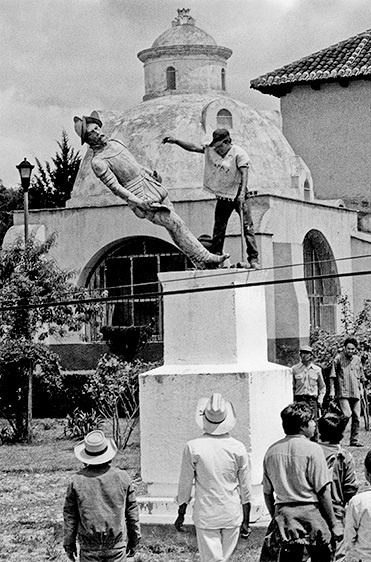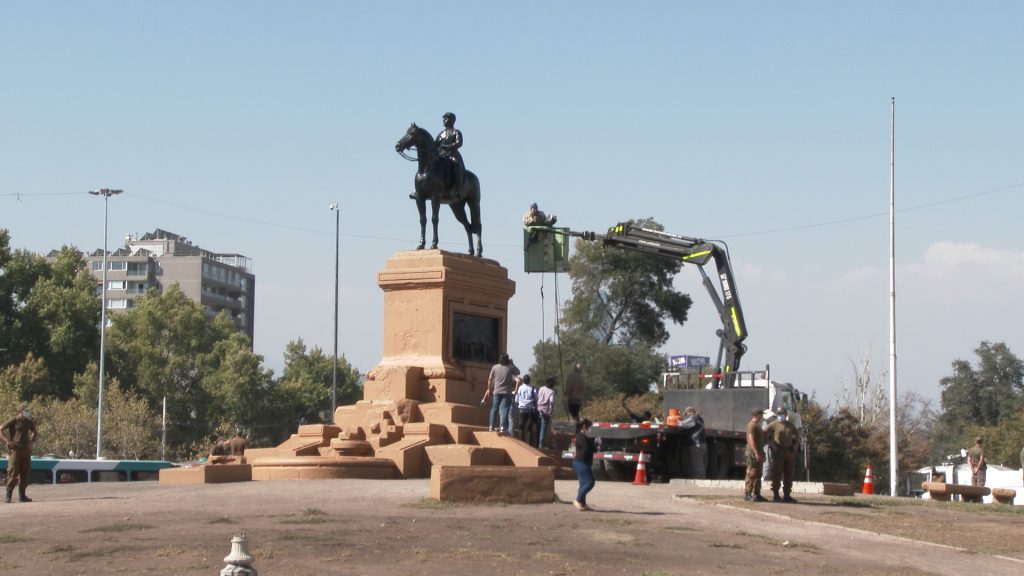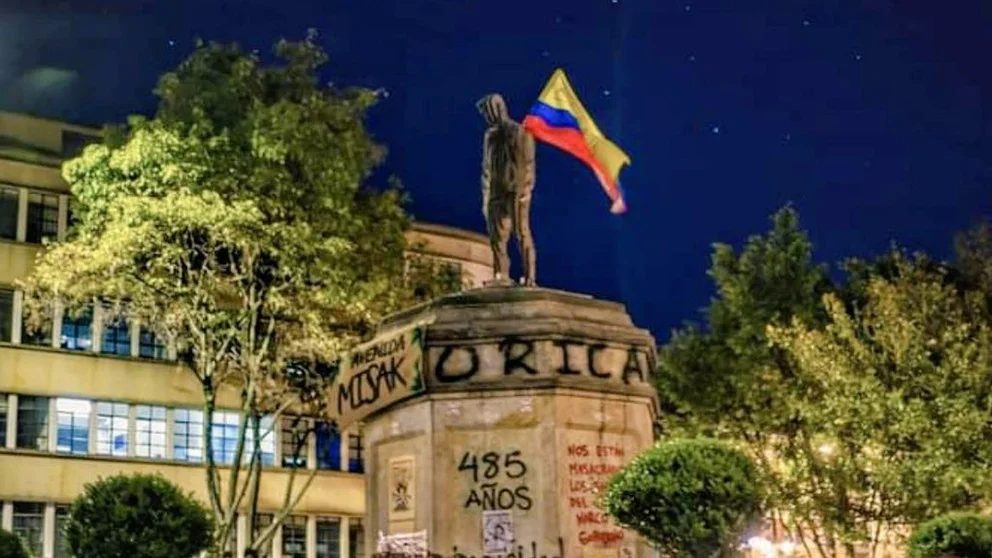Claudia Wasserman, PhD in Social History (Federal University of Rio de Janeiro – UFRJ), Professor of History at the Federal University of Rio Grande do Sul (UFRGS), CNPQ Researcher, founder-member of Luppa
Cover image: who had been killed by the Colombian police while demonstrating for public education. Statue of Dilan Cruz in Bogotá @NickMacWilliam 2021 (Twitter)
The toppling, removal or resignification of monuments that pay homage to controversial historical figures has divided the opinions of politicians, heritage specialists, historians and the general population. Amongst the supporters of such demonstrations are those who defend the need to revise a colonial history narrated as heroic by monuments that, while honouring the conquerors, also conceal slavery, genocide and spoliation. Those who oppose the removal of statues deem it anachronism to judge, in the 21st century, realities and values from the 19th century and centuries before. They consider the protests to be an unjustifiable form of presentism, or an erroneous historical reinterpretation. The latest events were precipitated by the murder of George Floyd in the United States, at the hands of a white police officer in Minneapolis, on 25 May 2020. The movement, which began in the United States as an anti-racial struggle, has spread across Latin America and has become a movement of colonial history revisionism and colonial legacy confrontation. Above all, the protests are directed not only against Spanish figures (or against figures of Spanish descent) who were part of the conquest and colonisation of America, but also against the founders of cities during the colonial period, metropolitan political proceres, and the clergy who came to America in order to catechise the indigenous population, as well as the leaders of the independence movements, and the politicians who established the national foundations in the 19th century. The movement against the heroicised memory of the conquistadores has crossed national boundaries, countering the nationalist framework of the elites that erected monuments to affirm their nation-states. This movement has also reclaimed the memory of the indigenous peoples, of black people and poverty-stricken white people who live in all countries in Latin America, regardless of the territorial boundaries set by the independence movements.
Since the end of the colonial period, around 1815-1825, the new Latin American countries have alternated between distancing themselves from and rapprochement with the Spanish culture – the monuments honouring historical colonial figures are proof of such oscillation. The newly formed countries’ adoption of the republican political system was an evident reaction against the imperial and monarchic metropolis. This rapprochement with Spanish culture began at the end of the 19th century. To the genocide and ethnocide committed by the conquistadores, we must add political, social and economic exclusion, as well as other forms of genocide, and the destruction of cultures, languages and traditions perpetrated by the Latin American elites, whose goal was to whiten the population of the new nations. Symbols of the metropolis were erected to represent the “arrival of the lights”, of civilisation against barbarism. The situation benefited Spain, which once more intended to reconquer America, this time from a cultural standpoint. In this particular case, the concept of Hispanicity (Hispanidad) bore more than just the colonial standpoint: it also contained the defence of the Spanish elite. This was fundamental in order to justify their authoritarianism during the 1920s and 1930s, and was intensified under Franco’s dictatorship. The monuments erected in Latin America in order to pay homage to the conquistadores, to the founders of colonial cities and villages, and the metropolitan military officers, comprised the historical narrative of the establishment of homogenous nations, founded under the ethos of whiteness, where the biography of the white elites represented modernity and progress, similar to the European standards, particularly in the former metropolis. On the occasion of the 400th anniversary of the “discovery” of America (1892), during the centennial celebrations of the independence movements (at the beginning of the 20th century), and upon the commemoration of the 400th anniversary of the foundation of the colonial cities (mid-20th century), dozens of monuments in honour of Spanish conquistadores, military officers and priests were erected in Latin America’s urban spaces. Each and every one of these monuments is a document of the political decisions concerning which past was worthy of celebration. The language, the religion, and the “Spanish race” were evoked in order to ramp up the construction of the national state. Latin American rulers encouraged nationalism by means of Hispanicity, and the heroes were brought to the stage with greater intensity, summoned up to integrate the different regions into the nation, to reaffirm the power of the elites, and to exclude those who were unwanted. Historical figures who had been given no recognition during their lifetime, who had often been controversial, polemic (some of them banished), would be honoured and deemed heroes between 50 and 400 years after their death. In this regard, such posthumous honours may also express anachronism, that is, a lack of correspondence between what those historical figures actually meant during their lifetime and their subsequent celebration.

The revolt against the statues seeks to bring to light other historical narratives; it also aims to tell the story of such concealments. Toppling, substituting, and damaging the monuments that honour colonial symbols calls into question the founding narrative of the white, male, heroic and victorious nations against the barbarism, the backwardness, the underdevelopment. This contention with colonial figures demands visibility, in the public space, for those identities that have been consigned to oblivion, and those memories that have been erased and vanquished. Attacks on statues are not a novelty in Latin America, particularly on those monuments related to the conquest and the colonisation process. In 1992, upon the 500th anniversary of Christopher Columbus’ arrival in America, the Latin American and Spanish rulers named the celebration “A meeting between two worlds and two cultures”, a title that caused an uproar among some Latin American intellectuals and protests from the indigenous peoples. Several monuments honouring colonial historical figures became the target of popular anger; for example, the statue of Spanish conquistador Diego de Mazariegos, who founded the colonial cities of San Cristóbal de las Casas and Chiapa de Corzo, in Chiapas (Mexico), was hammered down on 12 October 1992, before a crowd of 15 thousand people who had gathered to protest against the quincentenary celebrations that had been proposed to the American countries by Spain. On the same date, the Social Organisations Front from Chiapas (FOSCH) was created, uniting the associations of peasants and indigenous peoples.
Latin America, then governed by neoliberal politicians, saw the emergence of massive protests from the indigenous peoples, who had long been repressed and passive. Some native populations – who had bravely resisted slavery, annihilation, genocide, land expropriation and the destruction of their culture – erupted onto the Latin American political scene. In this part of the world, 500 indigenous languages are still spoken – a third of which are endangered. There are also more than 800 indigenous peoples, with a population of close to 45 million people, all of which are characterised by demographic, cultural, social and political diversity — from peoples who have chosen voluntary isolation to those who live in the great urban centres. Indigenous associations have been created and have spoken out in the political arena, such as the Confederation of Indigenous Nationalities of Ecuador (CONAIE) in Ecuador (1986); political parties such as the Pachakutik Plurinational Unity Movement – Nuevo País (1995), also in Ecuador; the political movement Winaq (2007) in Guatemala; and the Alternative Indigenous and Social Movement (MAIS) in Colombia; as well as an indigenous army that demands recognition: the Zapatista Army of National Liberation (EZLN, 1983). A number of experiences recognising autonomy and plurinationality have sprung from the struggle of indigenous peoples, allowing them to establish practices related to their cosmovision, the indigenous territories and their natural resources, their socio-political organisation, the administration of justice, education, languages, healthcare, medicine and the culture of the indigenous peoples. Among these are unprecedented constitutional experiences, such as that of Oaxaca in Mexico, autonomous indigenous regions in Nicaragua, autonomous indigenous territories in Colombia, plurinationality in the Constitution of Bolivia, and multiculturality in the Constitution of Guatemala. Politically active, the Latin American indigenous movements share similarities in different regions: they question the development model in force, and demand that their history and their memories, their historical figures and symbols be represented in the public space of Latin American cities. They also demand the demonumentalisation of the symbols of racism, prejudice, genocide and slavery. They spur on a fight that transcends national borders and is vested in an anti-colonial content of resistance against state power.
Between 2019 and 2021, due to the popular struggle and the disastrous management of the COVID-19 pandemic by the majority of Latin American governments, monuments became the target of protests once again. The 2019 protests broke out against conservative rulers who had come to power in the previous two years, or who had recently usurped it. At the beginning of the 19th century, most Latin American countries were governed by left-wing politicians (Lula da Silva/Dilma Housseff, Nestor/Cristina Kischner, Michelle Bachelet, Rafael Corrêa, Evo Morales, Hugo Cháves, Manuel Zelaya, José Mujica, Fernando Lugo, and Ollanta Humala, among others) who, through social inclusion policies, strengthened and empowered popular social movements. Nevertheless, the return of conservative neoliberalism to the subcontinent through elections or parliamentary coups (Jair Bolsonaro, Mauricio Macri, Sabastián Piñera, Jimmy Morales, Juan Orlando Hernandez, Pedro Pablo Kuczynski, and Lenín Moreno, among others) represented not only an affront to democracy, but also the cancelling of inclusive public policies, which has brought back unemployment, poverty, and a disregard for those who are most in need. Demonstrations against the removal of subsidies, the increase in public transportation fares, the changes to the healthcare and education loan systems, etc., came together with protests against the regression of civil and social rights for the majority of the populations of Latin American countries. In the context of conservative and neoliberal governments associated with austerity policies and violent repression against demonstrators, statues were once more targeted by the anger of social movements, directed against everything that represented a conservative, religious, retrograde, anti-intellectual and authoritarian ideology. For example, two statues of the Spanish conquistador Sebastián de Balalcázar were toppled in Colombian cities. The monuments, according to the Misak community (who claimed responsibility for the act) “are part of the symbolic violence” that “has oppressed them and put them in a place of oblivion”. The Mayor of Popayán regarded the act as vandalism, and offered a reward of 5 million pesos for anyone who would identify those responsible. In place of the toppled statue of Gonzalo Jiménes de Quesada, founder of Bogotá, an image of Dilan Cruz was placed, a student who had been killed by the Colombian police while demonstrating for public education. Colombian demonstrators tried to topple and set fire to the statue of Simón Bolívar, a Venezuelan military officer who fought for the independence of several Latin American countries. Also in Colombia, in the city of Barranquilla, the statue of Christopher Columbus was toppled. During the act, demonstrators shouted “Columbus, murderer” and flew the Wiphala, the flag of the indigenous peoples, which has increasingly gained prominence amid the demonstrations in Latin American countries. In Chile, monuments to conquistadores, military officers and colonial city founders – all of them Spaniards – were toppled, burnt, damaged, graffitied, or dressed in indigenous costumes; among them, Pedro de Valdivia, the founder of Santiago and other colonial cities, who waged war against the native populations and died at the hands of the natives. Two of his statues were toppled by the Mapuches; on one occasion, a statue was beheaded, and its head was placed in the hand of the statue that pays homage to the warrior Caupolicán, a symbol of indigenous resistance. The statue of Francisco de Aguirre, an officer of the Spanish colonisation, was torn down from its plinth and in its place the cardboard statue of a Diaguita woman, “La Milanka”, was installed; the cardboard statue was later burnt by unknown people. The monument to Manuel Baquedano (a Chilean military officer and politician who became the interim president of the country in 1891, and was a commander at the War of the Pacific), erected in Italy Square, was repeatedly defaced, until it was removed by the government. In its place, the demonstrators placed the image of a dog, “El negro matapacos”, a symbol of revolt. The statue of the founder of San Juan, in Puerto Rico (and the discoverer of Florida, in the United States), was toppled by demonstrators a short time before the visit of the king of Spain, Felipe VI, to celebrate the ties that unite the island to Spain, and in commemoration of the 500th anniversary of the city, founded by the Spanish in 1521.

Regardless of the polemic that has arisen between the advocates and the detractors of colonial monuments, I restrict myself to problematising the reasons behind the public anger against monumental heritage. The target of their protests are historical figures who have received homage as symbols of the arrival of the lights against the supposed darkness in which the aboriginal populations lived, and who, notwithstanding, committed atrocities in the name of civilisation and progress. In this regard, the removal of the statues is part of a reparation policy, through direct action by the victims themselves. The figures that have been honoured as symbols of the struggle for independence from the colonial yoke are now targeted by the demonstrations, as a way of bringing into the spotlight the dependence and underdevelopment that have persisted in the majority of Latin American countries. Finally, the figures who have been rendered posthumous homage, as symbols of whiteness, heroic masculinity and the identitarian homogeneity of the new nations, are targeted by protesters in order to reaffirm the absence of the memories of the natives, of black people, women, the oppressed, the unemployed, the marginalised and the impoverished middle classes — who face racism, machismo and class prejudice on a daily basis — from the public space. Responsibility for the attacks has been claimed by the Mapuche, the Chapanecos and the Misak community, and also by students, professors and intellectuals, who seek to assert that other stories, other memories, other narratives are necessary in order to break the paradigm of civilisation versus barbarism. Attacking those figures that have, for centuries, embodied the yoke of the elites or the victory of the invaders over the indigenous population is, in this sense, the expression of a cultural dispute, a dissent that challenges the foundations of domination. It establishes a path to be followed, on the ruins of that which has been destroyed, as a form of reparation and cultural recreation. Such actions aim to reveal the heterogeneity and complexity of Latin American cultures and societies. In the face of the crisis in modern rationality, and the supposed cultural homogeneity of the nation, social movements demand not only the right to life, but also the right to health, education, a decent home, food security and the right to memory.
Statues were erected in Latin American public space as a way of showing reverence to progress, and to forge the image of power and strength of countries that were headed towards modernisation, for the purpose of projecting international relations with the hegemonic capitalist centres, particularly those in Europe. The monuments were also erected to affirm that those who were absent from the public space – the native peoples, black people and the poor – were unwanted, for they represented backwardness, and to affirm that the great mass of black people, natives and poor people hindered the progress of Latin America in the developed world. The statues were a way of colonising public space through symbols of power.
Those statues were destroyed in order to expropriate the symbols of power, to decolonise public space, to assert that there are other memories, other forms of narrating the past. They were toppled so as to show that another form of development is possible, that neoliberalism and the entry into the globalised world have only inflicted more suffering on the forgotten peoples, and that the countries that revere heroes from the colonial past and from the newly independent nations continue to be profoundly dependent, both economically and culturally, and still remain socially unequal.
